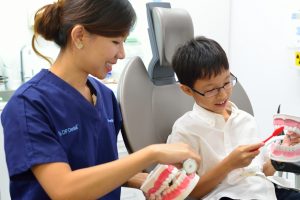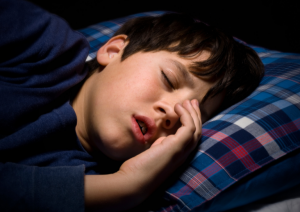Bruxism—or the more familiar term, teeth grinding, is a condition where you grind, clench and gnash your teeth. People might unconsciously grind their teeth while they are awake but in most cases, they grind them during sleep. The latter is called Sleep Bruxism.
There are many views on why bruxism happens in the first place. One view is that it is a natural development of synaptic pruning—the natural rewiring of the brain—that can occur in children between 3 to 10 years of age. Another view is the lack of space in the jaw that leads to the tongue partially obstructing the airway. When this happens, the lower jaw will move forward to open up the airway and as a result, the lower teeth will inevitably grind against the upper teeth.
Why is Sleep Bruxism on children concerning?
Sleep Bruxism if occurs occasionally is less of a concern. For some children, it is a normal occurrence and will resolve on its own. However, for some other children, it may be an indication of underdeveloped jaws, poor tongue posture and result in sleep disruptions which can affect growth, memory consolidation and hormone regulation.
 #1 Teeth wear, teeth crowding and underdeveloped jaws
#1 Teeth wear, teeth crowding and underdeveloped jaws
Bruxism has a strong association with the underdevelopment of the jaws. The underdevelopment of the jaws can lead to cosmetic concerns from teeth sticking out to a protruding lower jaw that may require surgery to correct in adulthood. This can be prevented with early intervention.
Bruxism can also result in cracked teeth, chipped teeth or cause teeth sensitivities from damaged tooth enamel (the hard surface surrounding the outer part of the tooth). Cracked teeth are less of a concern in baby teeth but when it occurs to an adult tooth, it may require a root canal treatment to treat the problem. This, too, can be avoided with early intervention.
#2 Sleep disruption
Sleep bruxism is associated with micro-arousals during the sleep cycle. A sleep cycle consists of different stages involving Non-Rapid Eye Movement (NREM) and Rapid Eye Movement (REM) sleep. REM sleep generally occurs after NREM sleep. REM sleep is involved in memory consolidation amongst other benefits to the human body. Sleep bruxism is associated with micro-arousals that occur in the brain preventing a child or adult from progressing from NREM sleep to REM sleep. Several studies have shown the links between teeth crowding, mouth breathing, sleep bruxism, poor tongue muscle tone with increased levels of stress, anxiety, Attention Deficit Hyperactivity Disorders and hormone dysregulation.
As mentioned, if bruxism occurs occasionally, it is less of a concern. However, if it occurs frequently and especially if accompanied by other symptoms such as mouth breathing, tongue-tie, teeth crowding and poor development of the upper and lower jaws, then early intervention is important.
Poor quality of sleep also affects a myriad of health-related problems that revolve around hormone imbalances. Growth and development will be affected due to the reduction of growth hormone production in children lacking good quality sleep. These children may be associated with being underweight or overweight.
Bruxism is also related to the increased production of the stress hormone cortisol. Increased cortisol production affects neurogenesis (the formation of nerve connections within the brain) in the hippocampus (an area of the brain involved with learning and memory)

#3 Stress and anxiety
Children may also experience bruxism due to stress and anxiety. Bruxism may be an indication of sympathetic dominance (fight-or-flight response). Our bodies have a fight or flight response which is controlled by the sympathetic nervous system and a “rest, digest and relax” response which is dominated by the parasympathetic nervous system. I will discuss more on this in subsequent email articles.
Bruxism may be a manifestation of sympathetic dominance in children and adults. Our stressful lifestyles accompanied with excessive screen time and a diet of processed foods add lots of stress to our body to cope with leading to sympathetic dominance where our bodies are constantly in a fight or flight mode. During night time, this manifests in unconscious clenching and grinding of the teeth during sleep.
Practising good sleep hygiene such as avoidance of screen time 1-2 hours before bedtime, maintaining a healthy diet with lots of fruits and vegetables and cutting down on processed foods go a long way in reducing sympathetic dominance in our bodies.
What are the signs to look out for?
The first thing you can do is to check on your kid while they are asleep. If you hear harsh grinding and gnashing sounds, your child is most likely dealing with bruxism. Another noticeable symptom is when your child’s tooth surface is flat due to the repetitive grinding of teeth. Other signs to look out for are if your child sleeps on their tummy or sleeps with their mouths open. If they do so, simply use your fingers to close their lips or change their sleep posture so that they are sleeping on their sides. Sleeping on the side naturally places the tongue in a better position and prevents obstruction of the airway.
As much as it is important to self-diagnose, it is more advisable for you to bring your child to a dentist for a more accurate diagnosis. With regular dental checkups, your dentist can also detect the signs of teeth grinding early and suggest the right treatments accordingly.
Are you due for a dental checkup? Come book an appointment with us here!
Have a specific topic that you would like us to talk about? Just let us know!
References:
Machado, E., Dal-Fabbro, C., Cunali, P. A., & Kaizer, O. B. (2014). Prevalence of sleep bruxism in children: a systematic review. Dental press journal of orthodontics, 19(6), 54-61.
Lee, B. K., Glass, T. A., McAtee, M. J., Wand, G. S., Bandeen-Roche, K., Bolla, K. I., & Schwartz, B. S. (2007). Associations of salivary cortisol with cognitive function in the Baltimore memory study. Archives of general psychiatry, 64(7), 810-818.




